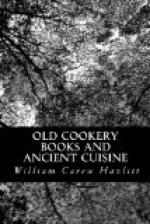The production by his Grace of Bolton’s other chef, John Middleton, is “Five Hundred New Receipts in Cookery, Confectionary, Pastry, Preserving, Conserving, Pickling,” and the date is 1734. Middleton doubtless borrowed a good deal from his predecessor; but he also appears to have made some improvements in the science. We have here the methods, to dress pikes a la sauce Robert, to make blackcaps (apples baked in their skins); to make a Wood Street cake; to make Shrewsbury cakes; to dress a leg of mutton like a gammon of bacon; to dress eggs a la Augemotte; to make a dish of quaking pudding of several colours; to make an Italian pudding, and to make an Olio. The eye seems to meet for the first time with hasty pudding, plum-porridge (an experiment toward the solidification of the older plum-broth), rolled beef-steaks, samphire, hedgehog cream (so called from its shape, currants being used for the eyes, and cut almonds for the bristles), cocks’-combs, orange, spinach and bean tarts, custards in cups (the 1723 book talks of jellies served on china plates), and lastly, jam—the real jam of these days, made to last, as we are told, the whole year. There is an excellent prescription for making elderberry wine, besides, in which Malaga raisins are to be largely used. “In one year,” says our chef, “it will be as good and as pleasant as French wine.”
Let us extract the way “to make Black-caps":—“Take a dozen of good pippins, cut them in halves, and take out the cores; then place them on a right Mazarine dish with the skins on, the cut side downwards; put to them a very little water, scrape on them some loaf sugar, put them in a hot oven till the skins are burnt black, and your apples tender; serve them on Plates strew’d over with sugar.”




